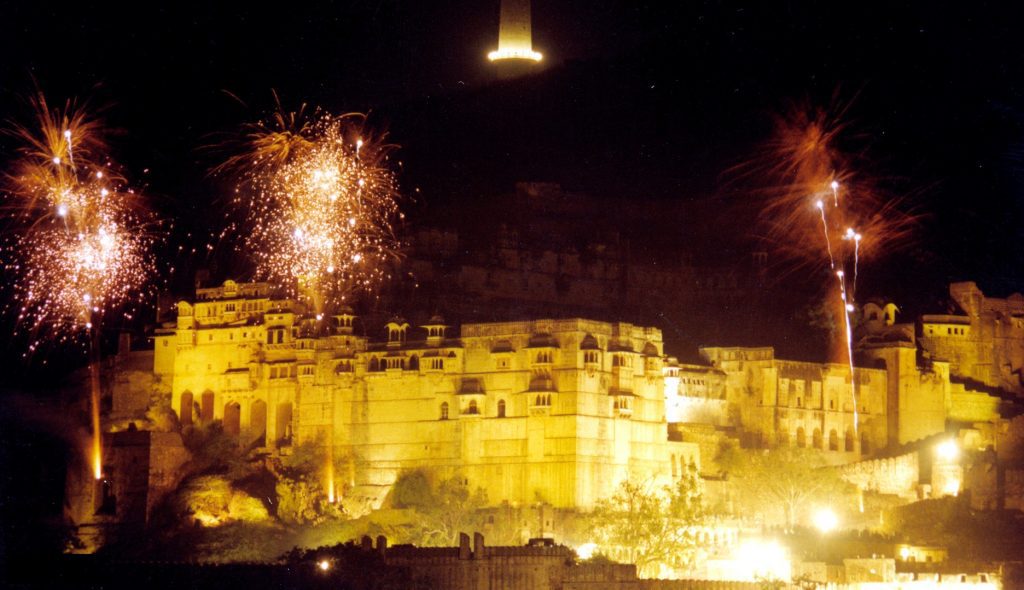Varanasi, often called Kashi or the ‘City of Lights’ by Hindus, is a city with deep roots. Some say its first inhabitants settled around 1000 BC. Legend has it that the city was created by the Hindu god, Lord Shiva, making it around 3000 years old. With its 87 riverfront steps, known as ghats, Varanasi is a living testament to ancient traditions.
If you’re equating Varanasi’s ghats with the western/eastern ghats of India, there’s a mix-up. “Ghats” are stairways that lead down to the Ganges River. Some, like Dashashwamedh Ghat and Manikarnika Ghat, are always buzzing with activity. Others are quieter spots where you can sit and watch the city come to life.
The moment you step onto any Varanasi ghat, you’re greeted by a lively mix of sights and sounds. You’ll see groups of pilgrims, busy priests in saffron robes, and tourists wandering around the main street, called Chowk. The riverbanks often feature holy men, known as sadhus, covered in ash. You’ll also hear haunting music and may even spot astrologers and palm readers. One of the best ways to experience the ghats is by taking a Savaari ride in Varanasi. It’s a feast for your senses and an experience you won’t forget. In this article, we’ll dive into the history of these ghats and highlight the ones you should visit when you’re in Varanasi.
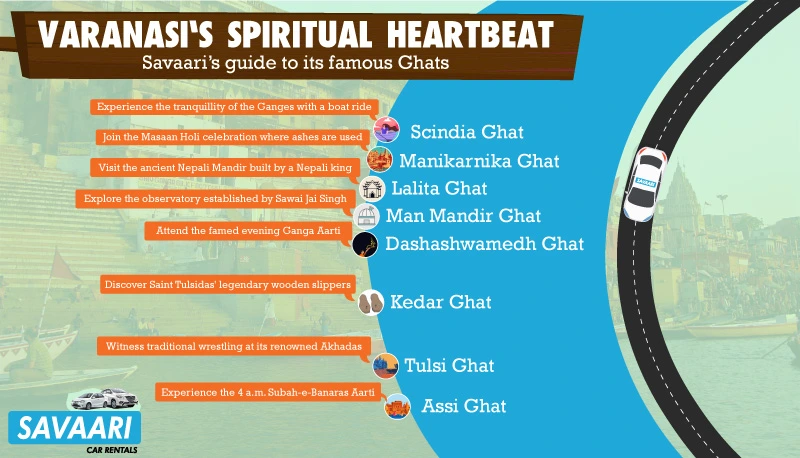
Varanasi Ghats – A tapestry of history, legends, and faith
Each ghat in Varanasi holds its unique history and significance. Some ghats commemorate notable figures like Tulsidas, who penned the revered Ramacharitamanas, serving as a beacon of wisdom for humanity. While many ghats have stories rooted in folklore or mythology, others remain under private ownership.
The majority of Varanasi’s ghats were reconstructed after 1700 AD during the Maratha Empire’s reign. The Marathas, Shindes (Scindias), Holkars, Bhonsles, and Peshwes (Peshwas) are credited as the key patrons of these ghats. Many are intertwined with legends, while others are privately held.
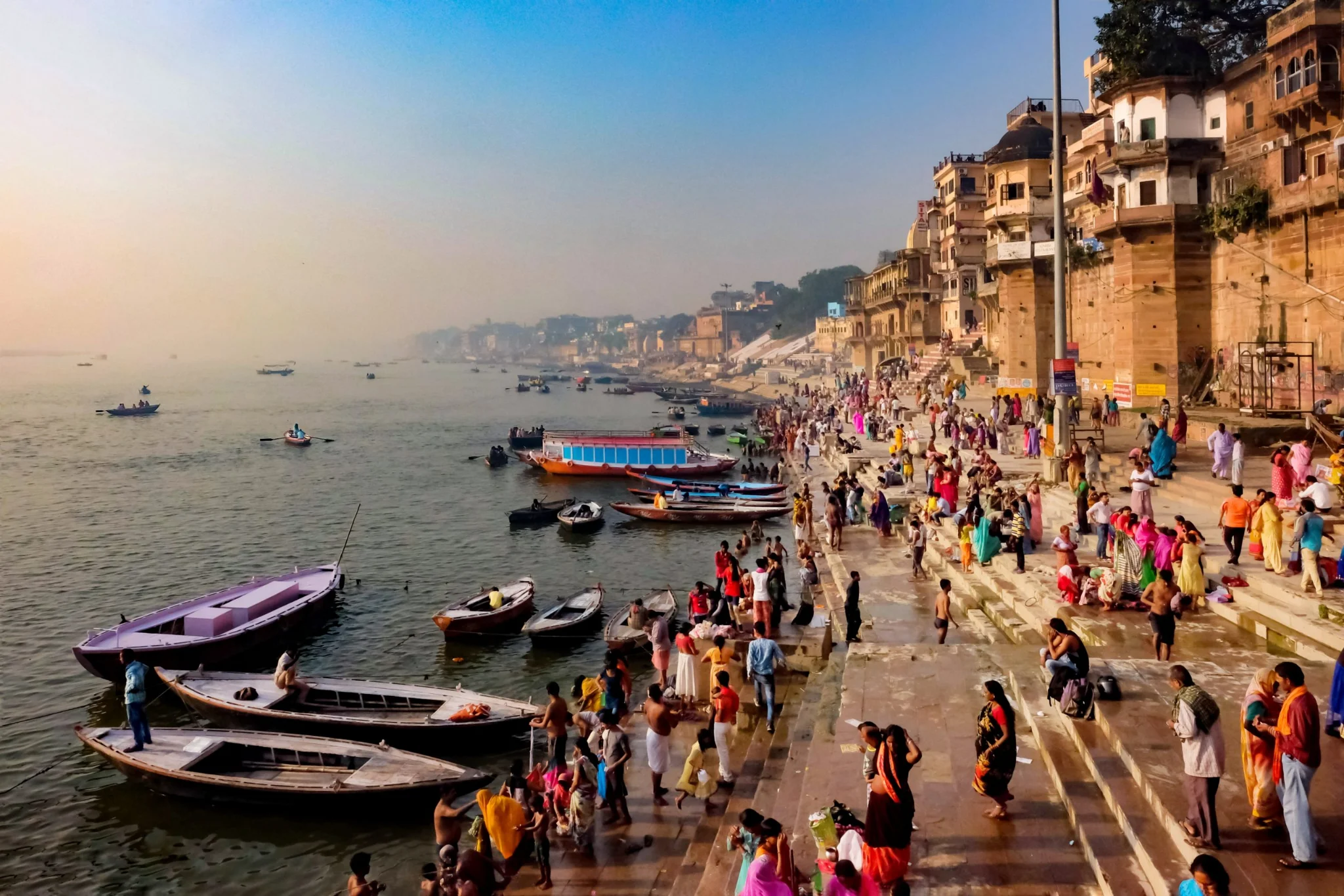
From life to liberation – Why Hindus choose Varanasi’s Ghats for cremation
While wandering around these Varanasi ghats, you might encounter the sight of deceased bodies. This is because the waters of the Ganga River are believed to be exceptionally pure, possessing medicinal qualities that benefit humanity in various ways, from aiding crop growth to medicine preparation. The Ganga stands as a symbol of purity, drawing many to its shores in their later years to cleanse themselves of sins and seek spiritual liberation.
The river is also seen as a flowing embodiment of eternal life. Consequently, many Hindus choose to have their loved ones cremated on the banks of the Ganga, particularly at the Manikarnika and Harischandra ghats, in the hope of achieving moksha, or liberation from the cycle of reincarnation.
Varanasi’s spiritual heartbeat – A guide to its famous Ghats
Varanasi is home to a diverse range of ghats, each radiating its own unique aura and significance. Often described as a gateway to the divine, Varanasi’s history and its ghats are a testament to this city’s spiritual essence. While some serve as venues for pujas and religious rites, others are designated for cremations, and a select few are privately owned. While covering all 87 ghats in a day might be overwhelming, familiarizing yourself with the ones highlighted below can guide you to those that resonate most with your interests. Among this vast array, let’s delve into some of the most distinguished and noteworthy ghats of Varanasi.
Dashashwamedh Ghat – The Heartbeat of Varanasi
Dashashwamedh Ghat stands out as the crown jewel among Varanasi’s numerous ghats. Not only is it the busiest, but it’s also deemed the most sacred, conveniently located near the revered Kashi Vishwanath Temple. Legend has it that Lord Brahma conducted the Ashwamedh Yagna here, sacrificing ten horses in the process. This tale gives the ghat its name, with “Dash” signifying ten and “ashwa” denoting horse.
Throughout the day, Dashashwamedh Ghat is a hive of activity. Under large umbrellas, pandits and purohits (scholars well-versed in religious scriptures) recite mantras and hymns. Devotees, with hands clasped in reverence, sit before them, immersed in prayer. The ambience is like stepping into another realm.
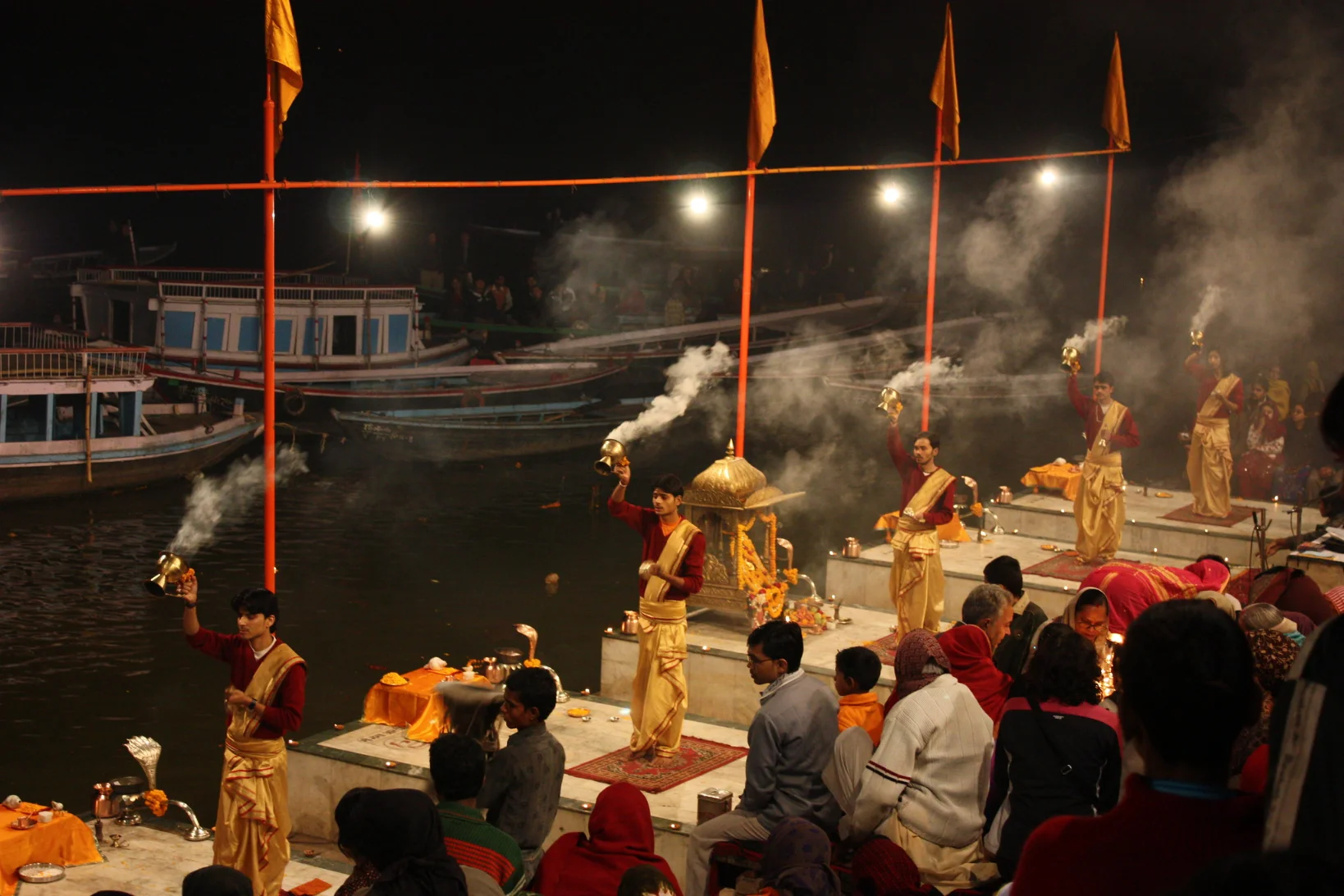
Come evening, the ghat becomes the stage for the famed Ganga Aarti. While it’s a magnet for tourists, its grandeur is undeniable. This ritual pays homage to the River Ganga, the setting sun (Surya), the element of fire (Agni), and Lord Shiva. During this time, the ghat and the boats anchored nearby are packed with spectators. Dashashwamedh Ghat is a living canvas. From dawn to dusk, it’s teeming with individuals, some seeking solace, others spiritual enlightenment. Amidst this bustle, be wary of a few opportunists preying on unsuspecting tourists. Spend some time here, and you’ll witness the full spectrum of life.
Things to do in Dashashwamedh Ghat
- Explore the Jantar Mantar observatory, a creation of Maharaja Jai Singh.
- Visit the Archaeological Museum near the Chaukhandi Stupa.
- Capture the unique sight of pandas (religious intermediaries) basking under bamboo umbrellas at this popular bathing ghat.
- Indulge in a relaxing massage by the ghat.
- Discover Varanasi’s vibrant past at the Bharat Kala Bhavan, which boasts an extensive collection of clay and bronze sculptures.
Assi Ghat – A serene retreat in Varanasi
Situated at the southern end of Varanasi, Assi Ghat is named after the Assi River and offers a tranquil contrast to the bustling Dashashwamedh Ghat. This ghat and its surrounding areas are favoured by students, long-term visitors, and international tourists, primarily because of its proximity to BHU and its peaceful ambience compared to the areas near Dashashwamedh Ghat and Kashi Vishwanath Temple.
Assi Ghat is steeped in mythology. Legend has it that after defeating the demon siblings Shumbha-Nishumbha, Goddess Durga discarded her sword at the Assi stream. This is where the Ganga gracefully converges with the Assi River. Known as the “Saimbeda Tirtha,” it’s believed that a single dip in the Ganga here grants blessings equivalent to all the Hindu pilgrimage sites. Many Hindu devotees visit during the Magh and Chaitra months (typically between January and April) to immerse themselves in the sacred waters. One of Assi Ghat’s highlights is the pre-dawn Subah-e-Banaras Aarti. Reserve your cab with Savaari so you can reach on time and soak in its glory. As hymns fill the air and the sun begins to rise, this ritual offers a mesmerizing start to the day.

Things to do in Assi Ghat:
- Don’t miss the enchanting Subah-e-Banaras morning Aarti at 4 a.m.
- Witness a breathtaking sunrise, as the ghat faces east.
- Join the complimentary yoga sessions held every morning.
- Savour the local gol-gappe from the makeshift shop near the Assi Choraha signboard.
- Relish a traditional breakfast of kachori-sabzi and jalebi.
- Enjoy a kulhad of chai at Assi Choraha’s Kashi Stall.
- The grandest Holi festivities take place in Varanasi, particularly at Assi Ghat, where the air is filled with an endless swirl of gulaal (dry color), adorning everyone’s once-white kurtas. If you happen to be in Varanasi during Holi, be sure to check out this guide to discover where you can immerse yourself in this iconic celebration.
Savaari recommends: Enjoy a slice of Italy at Assi Ghat
Vatika Pizzeria In the early ’90s, Varanasi welcomed its first pizzeria, thanks to some Italian students who persuaded Gopal Krishna Shukla to bake wood-fired pizzas for their musical gatherings at Assi Ghat. With mozzarella hard to find in Varanasi back then, Shukla journeyed to Nepal for his cheese supply. His apple pie, made with apples from Kashmir and Himachal, stands out amidst the numerous German bakeries claiming to use imported apples. If you’re in the mood for an authentic pizza experience, Vatika Cafe is the place to be.
Manikarnika Ghat – Gateway to Liberation
Manikarnika Ghat, one of the oldest and most revered Varanasi ghats, serves as the primary cremation site in the city. Rich in legends and tales, its significance is deeply rooted in ancient Hindu beliefs.
The legends of Manikarnika ghat
According to one legend, during the dawn of Satya Yug, Lord Vishnu sought Lord Shiva’s assurance that Kashi (Varanasi) would remain untouched when the world faced destruction. Pleased by Lord Vishnu’s devotion, Shiva granted Kashi eternal peace. In honour of Shiva and Goddess Parvati, Lord Vishnu created a pond using his Sudarshan Chakra. During a bath in this pond, a jewel (Mani) from his earring dropped into the water, leading to the naming of the ghat as Manikarnika. Another belief suggests that the earring of Sati, Lord Shiva’s consort, fell here after her self-immolation.
Manikarnika Ghat’s role in attaining Moksha
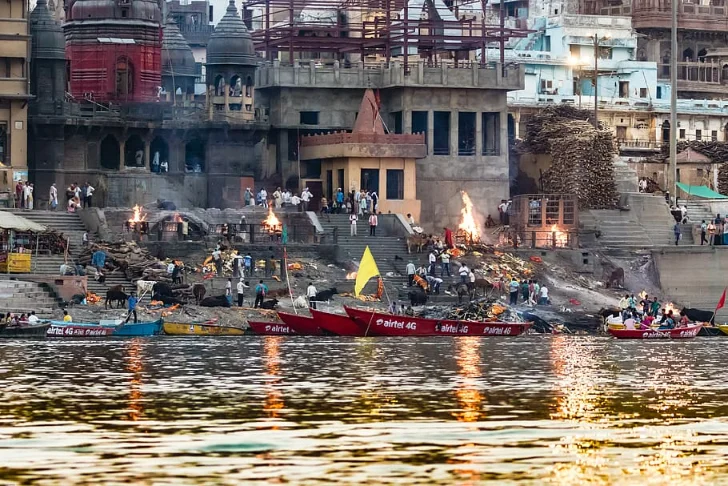
Manikarnika Ghat holds the promise of moksha or liberation from the cycle of birth and death. It’s believed that souls whose last rites are performed here attain this liberation. The ghat, though sacred, can be congested and somewhat unkempt. The pathway leading to it is lined with shops selling wood, essential for the cremation ceremonies. Boats loaded with wood are also a common sight nearby.
In Varanasi, even death is celebrated. It’s not unusual to witness processions carrying the deceased to Manikarnika Ghat, accompanied by drums and trumpets. While the rituals can be intense and graphic for those unfamiliar with Hindu customs, they are a testament to the city’s deep-rooted beliefs. However, if you find the scene overwhelming, it’s advisable to maintain a respectful distance. Beware of scams targeting foreign tourists, particularly the notorious “burning wood scam.” Also, stay cautious of individuals sharing sorrowful stories and requesting money for cremation wood.
Things to do in Manikarnika Ghat
- Experience Masaan Holi, a special Holi celebration at Manikarnika Ghat, where instead of colours, people join in the festivities by using ashes, known as ‘bhasm,’ for their unique way of celebrating.
- Visit the Kathwala Temple (Nepali Temple), reminiscent of Kathmandu’s Pashupatinath Temple.
- Pay respects at the Kashi Vishwanath Temple, also known as the Golden Temple, one of the 12 revered Jyotirlingas.
- Explore the Alamgir Mosque, a unique structure amidst the city’s temples, offering panoramic views of Varanasi.
- Shop for exquisite Banaras silk sarees at Bhole Silk Handicrafts.
Raja Harishchandra Ghat: The Eternal Flame of Faith
Harishchandra Ghat, another primary cremation site in Varanasi, is steeped in ancient lore and tradition. Among the oldest Varanasi ghats, it’s named after Raja Harishchandra, an ancestor of Lord Rama. Renowned for his unwavering truthfulness, the king is believed to have worked at this very ghat as a ‘dom’ – the individual responsible for cremating the deceased.
Many believe that cremations at Harishchandra Ghat predate even those at Manikarnika Ghat. As you traverse Varanasi, the lines between history, myth, and legend blur, making each step a journey through time and faith. The ‘doms’ at Harishchandra Ghat are custodians of a sacred fire that’s never allowed to be extinguished. This eternal flame, always visible at the ghat, is overseen by the Dom Raja, ensuring its perpetual burn. When a funeral pyre is lit, the inaugural spark is borrowed from this undying sacred flame.
Day and night, multiple pyres are aflame, bearing testament to the circle of life and death. With an estimated 800 cremations daily in Varanasi, the ghat can sometimes seem chaotic and untidy. Yet, it’s essential to approach it with respect and understanding, recognizing the deep faith it embodies for countless believers. If the sight is too intense, it’s best to maintain a respectful distance.
Chet Singh Ghat – A Blend of History, Spirituality, and Culture
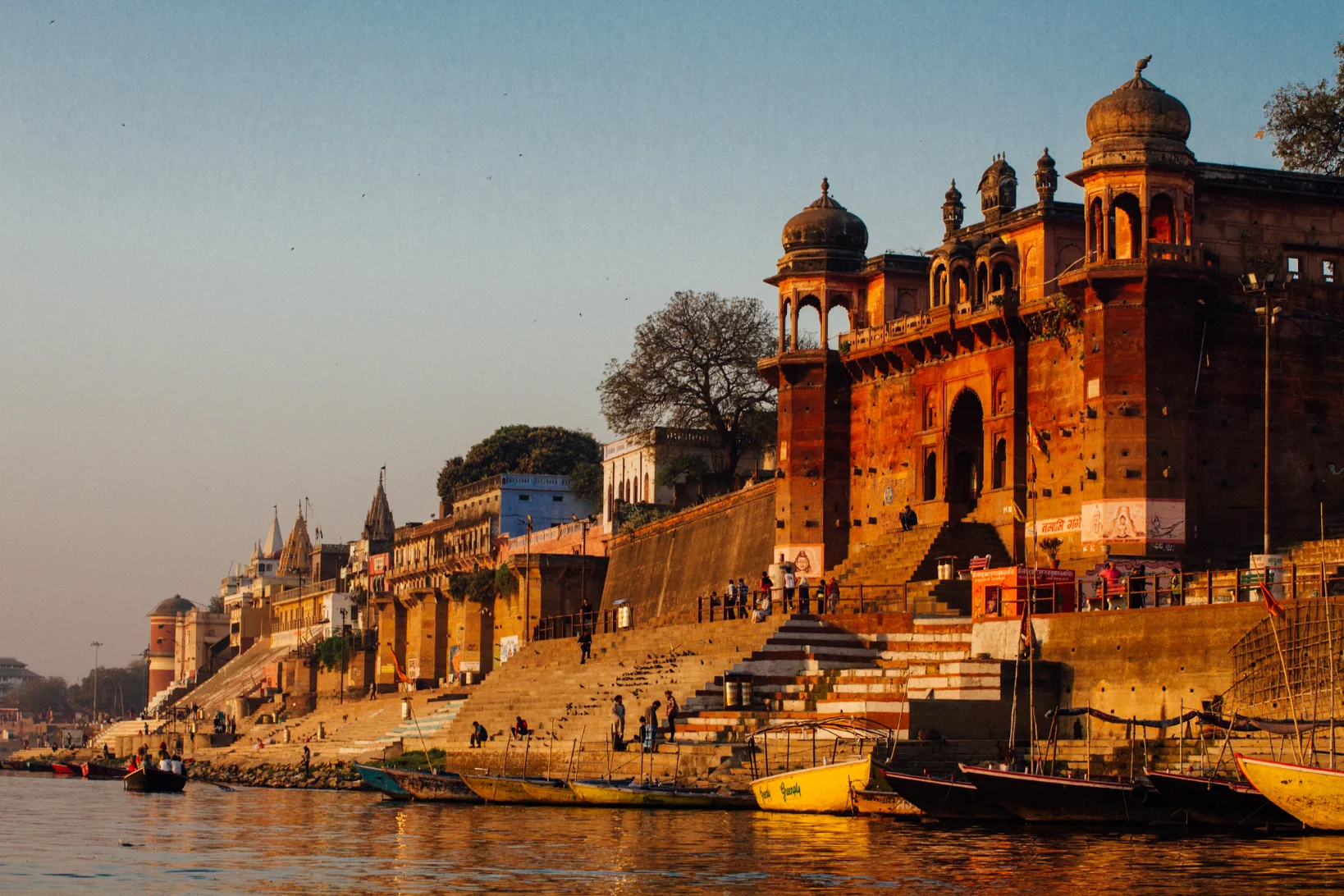
Chet Singh Ghat holds a special place among many Varanasi ghats, distinguished by an imposing fortress that was built in the mid-18th century by Maharaja Chet Singh, who used it as his primary residence. This historical site was the battleground for a fierce conflict between the forces of Warren Hastings and Maharaja Chet Singh in 1781.
Although the Maharaja was defeated and the fortress fell under British control, legend has it that he managed to escape. In the 19th century, the fort came under the ownership of King Prabhunarayan Singh. Later, the northern section of the fort was gifted to the Naga Sanyasis, a sect of ascetics known for their austere lifestyle. They constructed a temple and living quarters on the premises.
Things to do in Chet Singh Ghat
- Immerse yourself in the 300-year-old Budhwa Mangal festival, a week-long musical celebration held at this ghat.
- Experience the captivating evening aarti, a spiritual ritual that fills the air with devotion and serenity.
- While the ghat itself may not offer a plethora of activities, the surrounding alleys are rich with ashrams and vintage residential colonies, inviting you to explore and soak in the local atmosphere.
Darbhanga Ghat – A Blend of Heritage and Luxury
Darbhanga Ghat, among Varanasi’s renowned ghats, is graced by the majestic Brijrama Palace that stands tall, overlooking the Ganges. Constructed in the 18th century by the royal family of Nagpur, it’s one of the oldest forts adorning the riverfront. The fort’s ownership transitioned in the 20th century when it was acquired by Maharaja Rameshwar Singh Bahadur of Darbhanga.
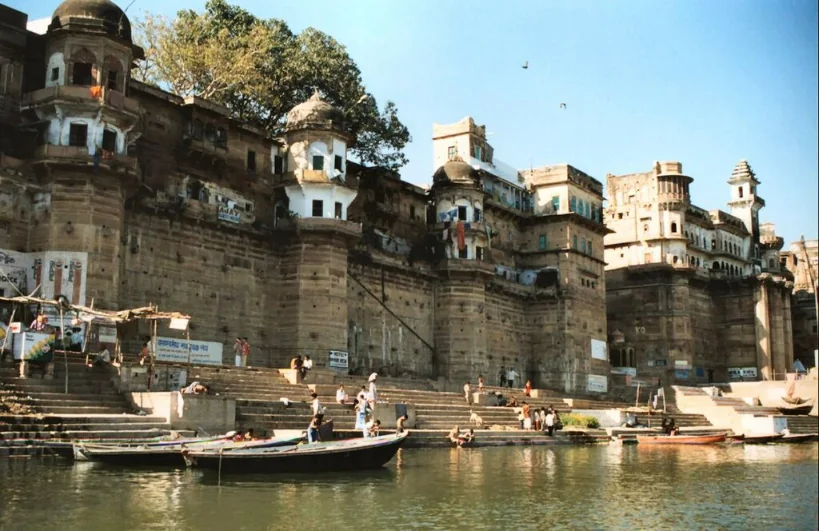
Under the Maharaja’s vision, the fort underwent extensive renovations, including the installation of South Asia’s first elevator. Today, the Brijrama Palace has been transformed into a boutique hotel, offering a luxurious oasis amidst the bustling ghats. The elevator, a testament to its rich history, now serves the hotel’s guests. Bathed in a soft pink hue, the palace radiates a unique charm, especially under the morning sun.
Things to do in Darbhanga Ghat
- Stroll along Darbhanga Ghat during sunset, soaking in the serene ambience.
- Venture into the lush Chandra Prabha Sanctuary for a refreshing hike.
- Explore Sarai Mohana, the weaver’s village renowned for its intricate gold and silver brocade and exquisite zari work on fine silks.
- Dive into the lively Thateri Bazaar, perfect for picking up souvenirs.
- Treat your taste buds to the local delights of Banarasi Kalakand and paan at the quaint shops of Godowilia Bazaar.
Meer Ghat – A Mélange of Culture and Religious Harmony
Nestled among Varanasi’s myriad ghats, Meer Ghat stands out with its unique history. Named in honour of the Muslim commander, Meer Rustam Ali, this ghat offers a blend of diverse religious influences. Every dawn, it’s common to see devout pilgrims offering flowers and raw rice to the Ganges, a gesture of reverence and devotion.

The ghat houses the religious landmarks of Jarasandhesvara and Vrdhaditya. Additionally, shrines dedicated to Asa Vinayaka, Yajna Varahaand, and Visalaksi are located at the Vrdhaditya site. Dharmakupa, another significant spot here, boasts a sacred well surrounded by five temples and a structure symbolizing the Divodasesvara lingam.
A notable episode in the ghat’s history involves Swami Karapatri, a conservative Brahmin leader. He believed that the ghat’s Visvesvara temple had been desecrated due to the presence of lower-caste individuals. In response, he founded the ‘New Visvesvara Temple’ in 1956, which now crowns the ghat.
Things to do in Meer Ghat
- Start your day with a sumptuous breakfast at the Varanasi Cafe & Bakery.
- Explore the ancient Batuk Bhairav Mandir, a testament to the city’s spiritual heritage.
- Delve into Varanasi’s Buddhist ties by visiting the towering Statue of Standing Buddha.
- Step back in time at the sandstone marvel, Ramnagar Fort, built in 1750. Its Mughal architectural brilliance is sure to captivate you.
Scindhia Ghat – Where History Meets Spirituality
Adjacent to the renowned Manikarnika Ghat lies Scindhia Ghat, notable for its half-submerged Shiva temple. This intriguing sight is a result of the temple’s collapse during the ghat’s construction in 1870. The ghat owes its name to the Scindhia dynasty, who sponsored its construction. Venturing behind Scindhia Ghat, visitors will find a labyrinth of narrow lanes dotted with ancient temples. This area, known as “Siddha Ksetra” or the land of fulfilment, is believed to be the birthplace of Agni, the Hindu God of Fire.
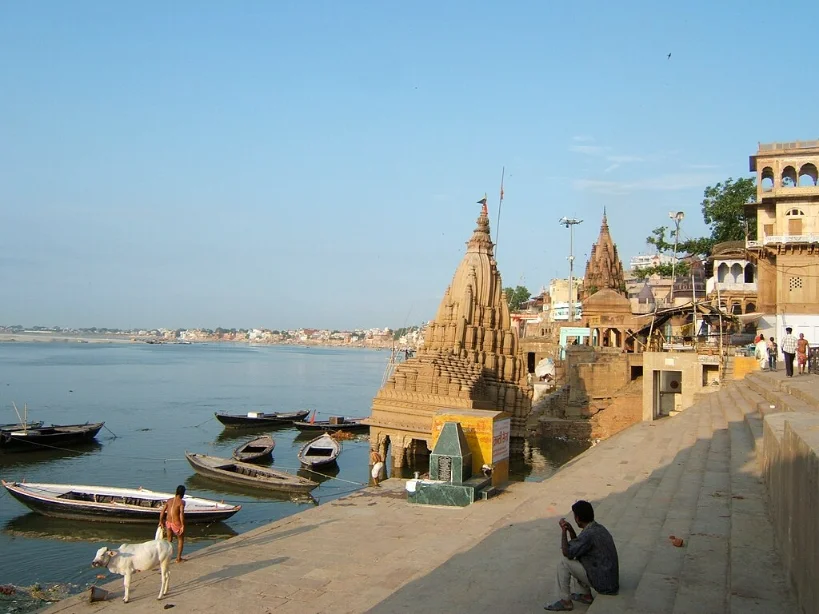
Things to do in Scindhia Ghat
- Experience the tranquillity of the Ganges with a boat ride, particularly enchanting under the evening sky.
- Embrace the spiritual essence of Varanasi by taking a purifying dip in the river at dawn, immersing yourself in moments of peace.
- Explore the 18th-century Durga Temple, a testament to the city’s rich religious heritage.
Ahilyabai Ghat: A Tribute to a Queen and a Spiritual Oasis
Ahilyabai Ghat stands out in Varanasi’s tapestry of ghats, being the first to be named after an individual, Queen Ahilyabai Holkar of Indore. Originally known as Kevalagiri Ghat, it transformed in 1778-1785 under the queen’s patronage. Today, it houses a residential palace and several temples, though their presence might not be immediately evident from a distance. Like many of Varanasi’s ghats, Ahilyabai Ghat conceals a world of its own behind its riverfront facade.
Things to do in Ahilyabai Ghat
- Sacred Dip: Engage in a time-honoured tradition by taking a purifying dip in the Ganges. Locals believe that bathing in these sacred waters cleanses one of the sins and sanctifies the spirit.
- Boat Ride: Experience the serenity of Varanasi from the waters. Embark on a boat ride, especially during sunrise or sunset, to witness the city in its full splendour.
- Ganga Aarti: Ahilyabai Ghat offers a prime vantage point to observe the mesmerizing Ganga Aarti. This ritual, characterized by the lighting of lamps and chanting of hymns, pays homage to the revered River Ganges. It’s a must-see for anyone visiting Varanasi, promising an experience that lingers in memory.
Babua Pande Ghat – A Tapestry of Colors and Culture
Babua Pande Ghat stands out in Varanasi’s myriad ghats, not for its intricate architecture or historical significance, but for the vibrant array of clothes that adorn it. This ghat becomes a canvas of colours as clothes of every hue are hung out to dry, painting a unique picture of everyday life in Varanasi.
The ghat’s origins trace back to the 19th century when it was made sturdy by Kavindra Narayan Singh. Its name, however, pays homage to Babua Pande, a wealthy Brahmin from Chhapra, Bihar. In 1805, he established a wrestling arena near the ghat, leading to its naming in his honour. Today, the ghat seems to be a favourite for local washermen, always bustling with the activity of washing and drying clothes.
Things to do in Babua Pande Ghat
- Tranquil Walks: Being one of the less crowded Varanasi ghats, it offers a peaceful environment for serene walks, especially during the evenings.
- Local Eateries: The ghat vicinity boasts some delightful eateries, with the Pizzeria being a notable mention.
- Unique Shopping: For those interested in unique souvenirs, the ghat offers original paintings and intricate stone carvings of animals.
- Relax and Observe: Grab a cup of tea from the local stall, find a spot on one of the benches, and immerse yourself in the mesmerizing views of the Ganges and the vibrant life around it.
Tulsi Ghat – A Blend of Poetry, History, and Spirituality
Tulsi Ghat, named in honour of the revered 16th-century poet Tulsi Das, holds a special place in the heart of Varanasi. Legend has it that the poetic genius penned the sacred ‘Ramcharitamanas’ right here. The ghat also claims the distinction of being the first stage for the Ram Lila, a dramatic retelling of Lord Rama’s life.
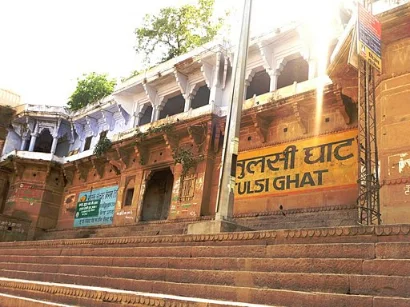
This historic performance led to the construction of a temple dedicated to Lord Rama on the ghat. The ambience of Tulsi Ghat is one of tranquillity and reflection. Its serene atmosphere, combined with the neighbouring Rewa Ghat, offers a space for introspection, conversations, and simply soaking in the beauty of the Ganges.
Things to do in Tulsi Ghat
- Krishna Leela during Diwali: If you’re visiting around Diwali, don’t miss the grand theatrical portrayal of Krishna Leela, which draws a sea of devotees and tourists alike.
- Lolark Kunda’s Blessings: Nearby lies the sacred waters of Lolark Kunda. Many believe that prayers here can grant wishes for progeny, and longevity, and even cure ailments like leprosy.
- Witness Traditional Wrestling: Tulsi Ghat is renowned for its Akhara or wrestling ground. An early morning visit, around 7 AM, offers a glimpse into the rigorous practice sessions of local wrestlers.
Bhonsle Ghat – A Maratha Legacy on the Ganges
Bhonsle Ghat, established by the Maratha King Bhonsle of Nagpur in 1780, stands as a testament to the Maratha influence in Varanasi. With its rich history and spiritual significance, the ghat offers visitors a unique blend of Maratha heritage and Varanasi’s timeless spirituality. Characterized by its distinctive gateway-like structure, the ghat is more than just a riverside location; it’s a hub of spiritual activity.
Things to do in Bhonsle Ghat
- Visit the Laxminarayan Temple: This temple is one of the primary attractions at Bhonsle Ghat, dedicated to Lord Vishnu and his consort, Lakshmi.
- Seek Blessings at Yameshwar Temple: Another significant shrine, this temple is dedicated to Lord Shiva.
- Contemplate at Yamaditya Temple: This temple, dedicated to Yama, the Lord of Death, offers a unique spiritual experience. It’s a reminder of life’s transience and the eternal cycle of birth and rebirth.
Jain Ghat: Whispers of Enlightenment
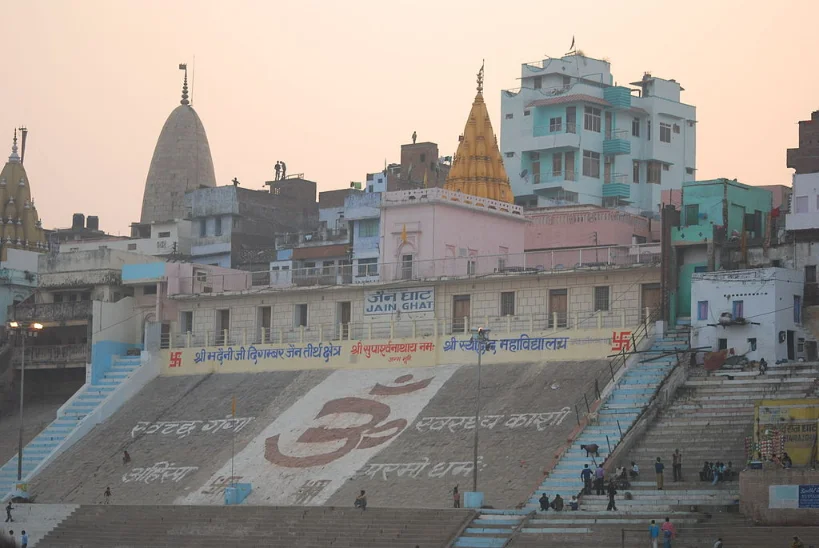
Jain Ghat, adorned with pristine white Jain temples, is a sight to behold, especially when illuminated with vibrant lights at night. Previously known as Vaccharaja Ghat, it was later renamed in honour of the Jain Tirthankara after being rebuilt by Babu Shekhar Chanda. The ghat holds special significance in Jainism, as it’s believed that the 7th Jain Tirthankara, Suparshvanatha, was born nearby. Furthermore, the ghat pays homage to Mahavira, a pivotal figure in Jainism.
Things to do in Jain Ghat
- Relax and Reflect: The ghat offers a serene environment, perfect for introspection as you gaze upon the Ganges. Its relatively peaceful ambience allows for hours of quiet contemplation, watching the world go by.
- Admire the Architecture: The Jain temples at the ghat are architectural marvels. Their intricate designs and the play of lights at night make them a must-visit.
- Witness Traditional Ceremonies: Jain Ghat is a hub for Hindu cremation rituals. If you happen to see one, remember to maintain silence and respect the sanctity of the moment.
- Dive into Local Cuisine: Nearby eateries, like Shanti Vihar Restaurant & Café, offer delectable North Indian vegetarian dishes. For a quick snack or a refreshing drink, Jain Ghat Café is the place to be.
- Shop and Explore: From trinkets and souvenirs to traditional attire and handicrafts, the shops around Jain Ghat have it all. Remember to haggle for the best deals!
- Nightlife: For those looking to unwind, several bars around Jain Ghat offer live music and dance. However, always be respectful, considering the ghat’s religious significance.
Manasarovar Ghat – A Dip into Sacred Waters
Manasarovar Ghat, constructed by Raja Man Singh of Amber, Jaipur in 1585, holds a special significance due to the Mansarovar Kund. This pool is believed to possess the same sanctity as the revered Mansarovar Lake in Tibet. Over time, urban development has transformed the Kund into the Mansarovar Kupa. The Kumaraswamy Mutt, a notable religious establishment, is situated atop this ghat.
Things to do in Manasarovar Ghat
- Sacred Dip: Taking a dip in the waters of Manasarovar Ghat is believed to bestow the same blessings as immersing oneself in the Himalayan Mansarovar Lake.
- Visit Kumarswamy Mutt: Explore this religious establishment and delve into its spiritual significance.
Rajendra Prasad Ghat: A Tribute to India’s First President
In 1979, the ghat in Varanasi was renamed in tribute to Dr. Rajendra Prasad, India’s first president (1884-1963). The Varanasi Municipal Corporation took the initiative to renovate and improve it. Originally, this ghat was an extension of the Dasashamedha Ghat. Historically, a stone statue of a horse stood here, marking the ‘ten-horse sacrifices’ conducted by the Bhara Siva Nagas in the second century.
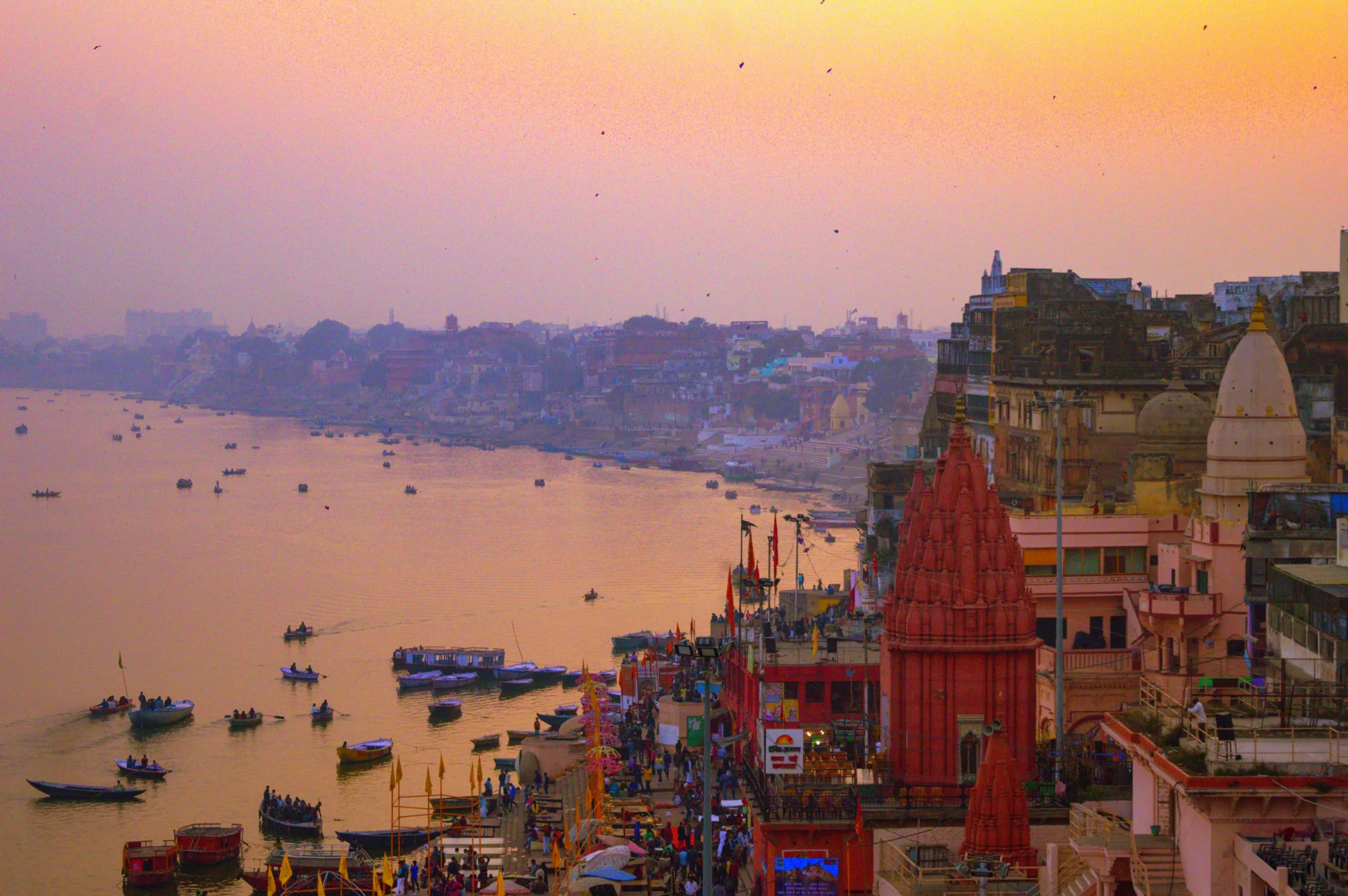
This is why it was formerly known as ‘Ghoda Ghat’ or ‘Horse Ghat’. It’s said that this horse statue was later moved to the Sankatmochan Temple, a renowned temple dedicated to Lord Hanuman in the southern part of the city. Today, the ghat is not just adjacent to the Dasaswamedh Ghat but is also famous for the mesmerizing Ganga Aarati. This evening ritual, which began in the 1990s, is a grand ceremony to honour the sacred Ganga river. Both locals and tourists, from India and abroad, flock here to witness this breathtaking event.
Things to do in Rajendra Prasad Ghat
- Witness the Ganga Aarati: The grand Ganga Aarati at this ghat is a sight to behold. Every evening, a mesmerizing ritual is performed to venerate the holy Ganges, attracting both domestic and international visitors.
- Historical Exploration: Delve into the history of the ghat, from its origins as Ghoda Ghat to its current significance.
- Relax and Reflect: The serene ambience of the ghat, combined with its historical and spiritual significance, makes it an ideal spot for introspection and relaxation.
Kedar Ghat: A Predominately South Indian Spiritual Hub
Kedar Ghat, nestled in the heart of Varanasi, stands out with its vibrant Dravidian-style temple gracing its banks. Named after the revered Kedareshwar Temple, this ghat pays homage to Lord Eshwar, another name for Shiva. The ghat’s establishment traces back to the reign of the Vijayanagar King.
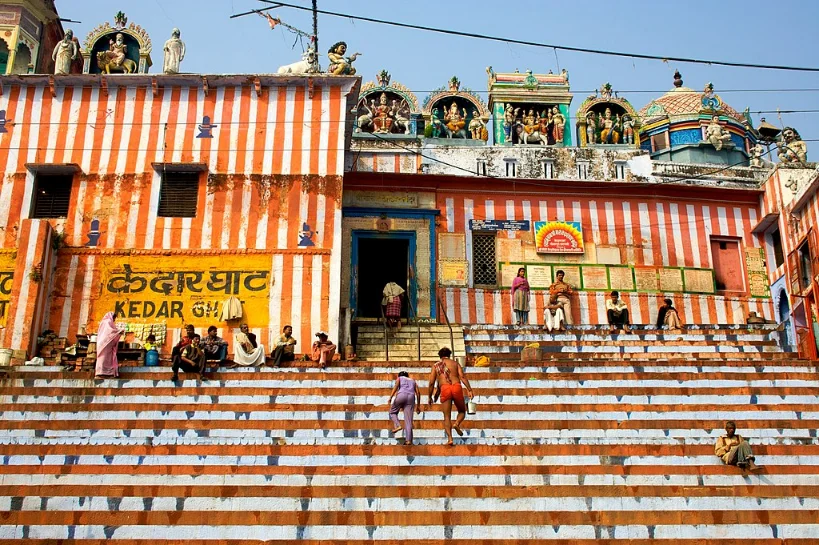
As you stroll along Kedar Ghat, you’ll often find South Indian devotees immersed in their rituals, bathing, and praying at the temple. Nearby, the Gauri Kund once believed to possess medicinal properties, now fills up only during the monsoon. An intriguing piece of history linked to this ghat is the wooden slippers (Khadau) believed to have been worn by the renowned Saint Tulsidas, the composer of the Ramayana.
Things to do in Kedar Ghat
- Evening Aarti: A must-visit during the evening aarti, the ghat comes alive with the harmonious chants, the glow of diyas, and the resonating bell sounds, enveloping the area in a spiritual ambience.
- Holy Month of Sravan: Experience the ghat’s magnificence during Sravan (July/August) when it’s bustling with devotees and tourists.
- Photography: For those with a keen eye for photography, the ghat offers myriad opportunities to capture its essence, from the rituals to the architectural beauty.
- Kedareshwar Temple: Pay your respects at this temple dedicated to Lord Eshwar.
- Gauri Kund: Discover the tales of this once-medicinal pond, especially when it’s filled during the monsoon.
- Saint Tulsidas’ Khadau: Seek out the legendary wooden slippers believed to belong to Saint Tulsidas.
Man Mandir Ghat: History, Architecture, and Spirituality
Man Mandir Ghat stands as a testament to the grandeur of Rajput architecture. Constructed in the mid-1600s, the ghat is adorned with a magnificent palace built by Maharajah Man Singh of Jaipur. Later, in the summer of 1730, Sawai Jai Singh II added an observatory, which remains well-preserved to this day. The instruments within this observatory still stand, a testament to the meticulous care and maintenance of the ghat. From the expansive terraces of the palace, one can soak in panoramic views of the Ganges, capturing the essence of both its banks.
Things to do in Man Mandir Ghat
- Rajput Palace: Marvel at the intricate Rajput architecture of the palace built by Maharajah Man Singh.
- Observatory: Explore the observatory established by Sawai Jai Singh II and get a glimpse of the ancient astronomical instruments.
- Temples: Pay homage at the temples of Sthuladanta Vinayaka, Rameshwara, and Someshwara, each holding its unique spiritual significance.
- Gyanvapi Mosque: Visit Aurangzeb’s Gyanvapi Mosque, a symbol of Mughal architecture and history.
- Buddhist Stupas: Immerse yourself in Buddhist culture by visiting the Dhammek and Chaukhandi stupas.
- Pillars of Ashoka: Take a historical journey as you stroll by the Pillars of Ashoka, bearing inscriptions and tales from the past.
Lalita Ghat: A Nepali Legacy in the Heart of Varanasi
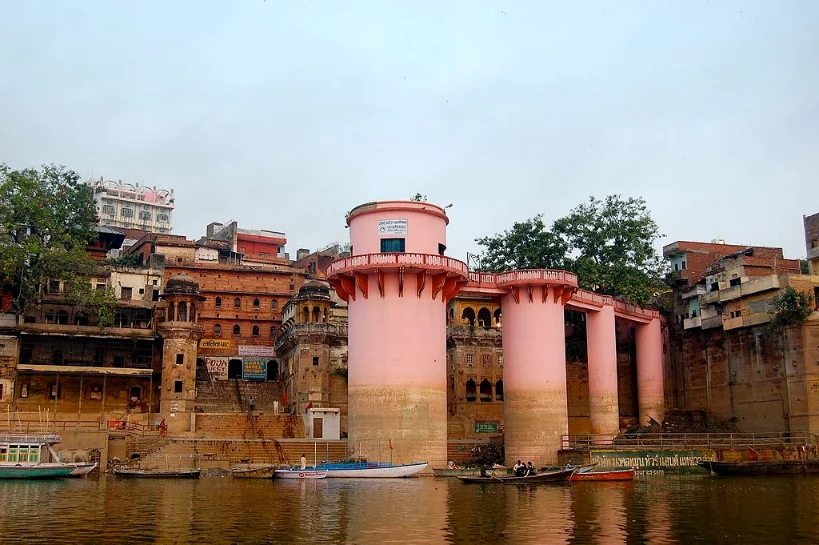
Nestled within India’s vast expanse lies a small fragment of Nepal: the Lalita Ghat, also known as the Nepali Ghat. At first glance, it might seem like any other ghat in Varanasi. However, ascend its steps, and you’re greeted by a distinctive two-tiered pagoda made of terracotta, stone, and wood, standing tall amidst Varanasi’s temple-laden skyline. This ghat’s origin is unique; while most of Varanasi ghats were commissioned by Indian monarchs, Lalita Ghat was the vision of Rana Bahadur Shah, the 19th-century Nepalese King. Today, it houses two temples: the Nepali Mandir, renowned for its age and termite-resistant wood, and the Lalita Gauri Mandir.
Named in honour of Goddess Lalita, a revered deity among the ten Mahavidyas in Hinduism, this ghat embodies her essence as the supreme form of Goddess Adi Shakti. Its history is as captivating as its architecture. During his exile in the early 19th century, Rana Bahadur Shah came to Varanasi and initiated the construction of a temple reminiscent of Nepal’s iconic Pashupatinath Mandir. Though he returned to Nepal before its completion, his son, Girvan Yuddha Bikram Shah Deva, ensured its fruition, extending the project to include a dharamshala and the ghat itself. The entire complex’s construction spanned over two decades.
Things to do in Lalita Ghat
- Engage in spiritual rituals, promising prosperity and happiness under the blessings of Goddess Lalita.
- Enjoy a serene boat ride, capturing the essence of the place.
- Delve into the architectural marvel of the Nepali Temple.
- Photograph the surroundings, capturing the unique blend of Nepali and Indian architecture.
- Explore the temple’s sculptures, reminiscent of those at Khajuraho.
Panchganga Ghat: Tides of Significance
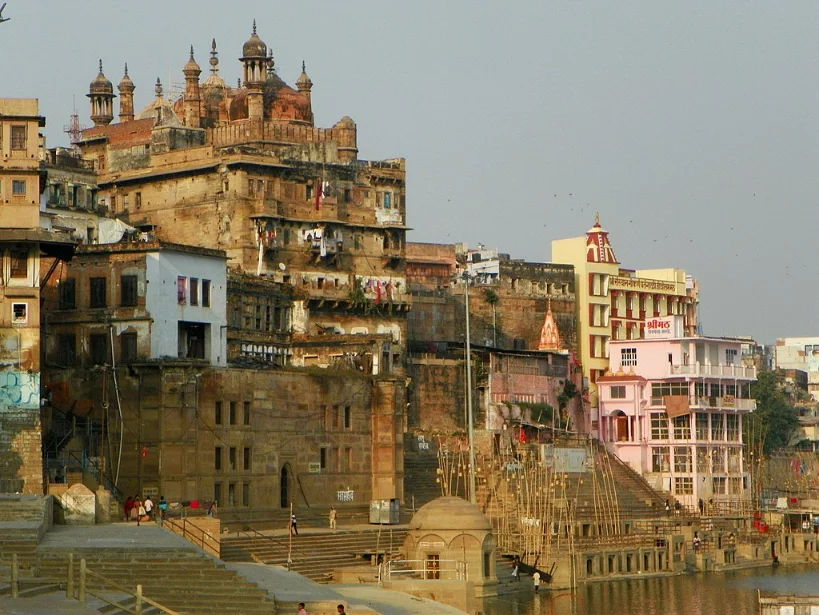
Often overlooked by the casual tourist, Panchganga Ghat stands as a significant landmark among the Varanasi ghats. This sacred spot is revered as the meeting point of five rivers. Legend has it that two symbolic streams, Dhutapapa (sin-cleansing) and Kirana (sun’s rays), converge with the three ancient Indian rivers: Ganga, Yamuna, and Saraswati. A shrine commemorating these five rivers graces the ghat.
The ghat also holds historical significance. It is said to be the place where the renowned Sufi Saint Kabir encountered his mentor, Vaidant Ramanand, and embarked on his spiritual journey. Additionally, the celebrated poet Tulsi Das is believed to have penned the revered Vinay Patrika at this very location. Panchganga Ghat stands as a testament to Hindu-Muslim unity, with its rich tapestry of intertwined histories.
Dominating the ghat’s skyline is the majestic Alamgir Mosque, commissioned by the Mughal Emperor Aurangzeb. Interestingly, this mosque was built on the grounds of the Bindu Madhava Temple, dedicated to Lord Vishnu. Locals fondly refer to the mosque as Beni Madhav-ka-Darera.
Things to do in Panchganga Ghat
- Alamgir Mosque: This architectural gem offers panoramic views of the river. Consider climbing its minarets for a serene experience.
- Lit Baskets Ritual: During specific months, evenings at the ghat come alive as illuminated baskets float gracefully on the river.
- Sunrise Viewing: The ghat offers a mesmerizing view of the sunrise, a sight that shouldn’t be missed.
- Meditation: With its spiritual ambience, Panchganga Ghat provides an ideal setting for meditation and introspection.
Gaay Ghat: Culture, Rituals, and Reverence
Situated along the serene banks of the Ganges in Varanasi, Gaay Ghat, often spelt as Gai or Gaye Ghat holds historical and cultural significance. The name “Gaay” translates to “cow” in Hindi, and as the name suggests, this ghat was traditionally used for washing cows. A distinguishing feature of Gaay Ghat is the 3-foot tall sculpture of a bull, further emphasizing its association with cattle.
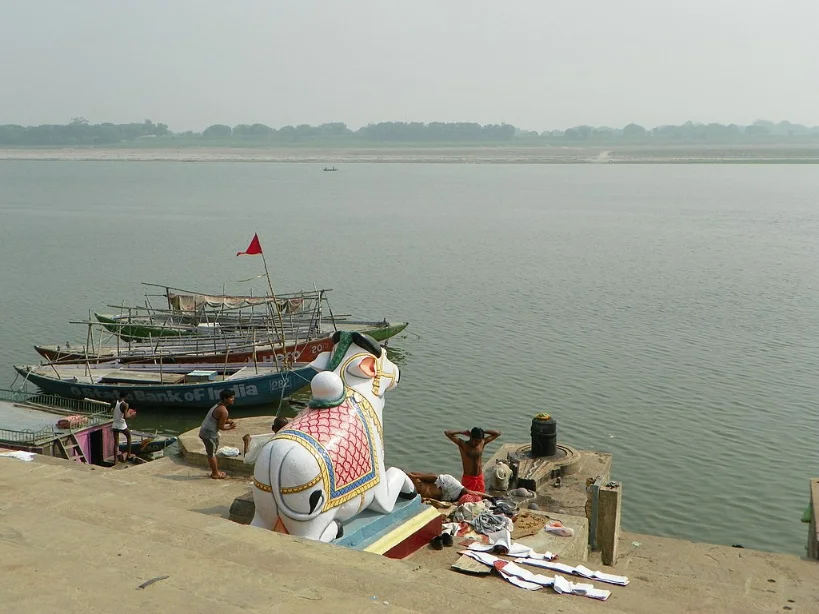
Historically, in the 12th Century, Gaay Ghat marked the southern boundary of the primary city of Varanasi. Early 17th-century texts and paintings depict cows quenching their thirst at this ghat. Fast forward to the 19th century, and a portion of this ghat, along with part of Badri Narayan Ghat, was fortified by Balabai Sitole from the Gwalior State.
Things to do in Gaay Ghat
- Cultural Activities: Gaay Ghat is a hub of activity among the southern ghats of Varanasi. From traditional ceremonies like Mundan (head-shaving ritual) and weddings to both religious and recreational events, the ghat is a vibrant centre of life.
- Shivalings: The steps of the ghat are adorned with both ancient and recent Shivalings, strategically placed in front of the Nandi (Bull) statue.
- Cleanliness: Unlike some other Varanasi ghats, Gaay Ghat is well-maintained and frequented by both locals and pilgrims.
- Evening Aarti: A spiritual experience not to be missed, the locals conduct evening aarti with fervour and devotion.
- Festive Celebrations: The ghat comes alive during major festivals, especially during Dev Diwali when it’s adorned with intricate Rangolis and eco-friendly decorations.
- Nearby Attractions: Consider visiting the Gaay Ghat temple, the Shri Swaminarayan Mandir, and the Machodari Park for a comprehensive experience of the area.
Adi Keshava Ghat: Where Divinity Meets Nature
Situated where the Varuna River merges with the Ganges, Adi Keshava Ghat stands as a significant boundary marker for Varanasi, akin to the Assi Ghat. The ghat is named after Adi Keshava, signifying the “Original Vishnu.” According to legends, it was here that Lord Vishnu first set foot in Kashi, representing Lord Shiva. However, during the monsoon season, the ghat becomes inaccessible due to rising water levels. Several shrines dedicated to Lord Ganesha can be found in its vicinity.
Things to do in Adi Keshava Ghat
- Adi Keshava Temple: A visit to the ghat is incomplete without ascending the steps to the Adi Keshava Temple. Positioned at the confluence of the Varuna and Ganga rivers, the temple exudes an aura of tranquillity and ancient divinity.
- Serene Beauty: The temple’s location offers a picturesque view, allowing visitors to immerse themselves in the profound energy of the divine.
- Meditative Space: The spacious precincts of the temple and the adjacent ghat provide a perfect setting for introspection. Sitting by the river, one can feel a deep connection with nature and the universe.
- Cultural Immersion: The confluence is not just a meeting point of rivers but also a melting pot of rituals, diverse people, and the rich tapestry of Indian culture.
- Architectural Marvel: The temple’s design stands out, showcasing a unique blend of traditional Indian architectural styles that tug at the heartstrings of its beholders.
List of all Varanasi Ghats
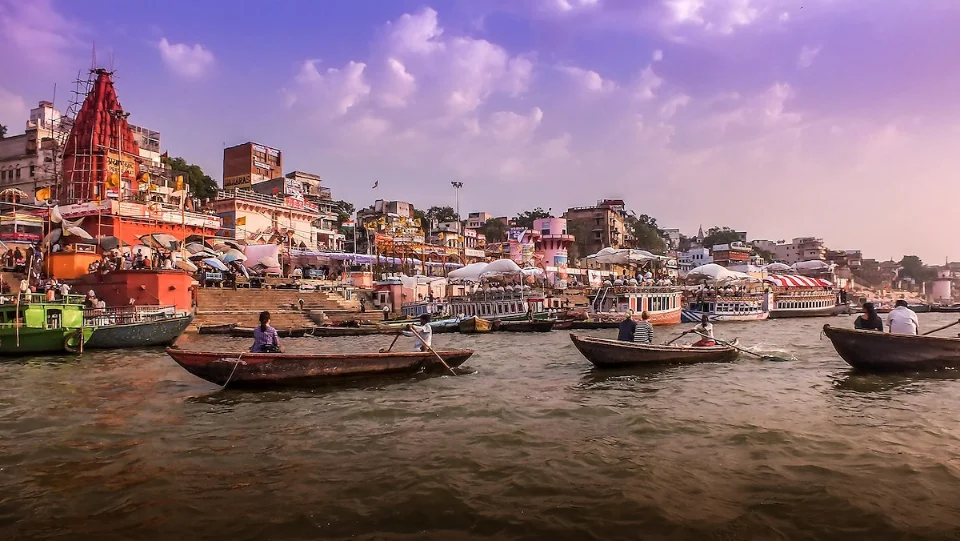
| Adi Keshava Ghat Ahilya Ghat Ahilyabai Ghat Assi Ghat Badri Nayarana Ghat Bajirao Ghat Bauli /Umaraogiri / Amroha Ghat Bhadaini Ghat Bhonsale Ghat Brahma Ghat Bundi Parakota Ghat Chaowki Ghat Chausatthi Ghat Cheta Singh Ghat Dandi Ghat Darabhanga Ghat Dashashwamedh Ghat Digpatia Ghat Durga Ghat Gaay Ghat Ganga Mahal Ghat (I) Ganga Mahal Ghat (II) Genesha Ghat Gola Ghat Gularia Ghat Hanuman Ghat Hanumanagardhi Ghat Harish Chandra Ghat Jain Ghat Jalasayi Ghat Janaki Ghat Jatara Ghat Karnataka State Ghat Kedar Ghat Khirkia Ghator Namo Ghat Khori Ghat Lala Ghat Lali Ghat Lalita Ghat Mahanirvani Ghat Mana Mandira Ghat Manasarovara Ghat Mangala Gauri Ghat | Manikarnika Ghat Mata Anandamai Ghat Meer Ghat Mehta Ghat Munshi Ghat Nandesavara Ghat Narada Ghat Naya Ghat Naya Ghat Nepali Ghat Niranjani Ghat Nishad Ghat Old Hanumanana Ghat Pancaganga Ghat Panchkota Pandey Ghat Phuta Ghat Prabhu Ghat Prahalada Ghat Prayaga Ghat Raj Ghat Raja Gwalior Ghat Rajendra Prasad Ghat Ram Ghat Rana Mahala Ghat Rewan Ghat Sakka Ghat Sankatha Ghat Sarvesvara Ghat Scindia Ghat Shitala Ghat Shivala Ghat Sitala Ghat Somesvara Ghat Telianala Ghat Trilochana Ghat Tripura Bhairavi Ghat Tulsi Ghat Vaccharaja Ghat Venimadhava Ghat Vijayanagaram Ghat |
How to reach Varanasi Ghats
If you’ve chosen to stay in Varanasi’s Old City, you’ll find yourself conveniently close to several ghats. While a leisurely walk along the ghats is an experience in itself, the best way to witness their beauty is from the waters of the Ganges. If you aim to explore multiple Varanasi ghats in a day, consider booking a Savaari car service for seamless city navigation. Start your day with a mesmerizing sunrise boat ride, and let your chauffeur await your return.
For those travelling from Delhi, consider using the Savaari service for a comfortable journey to Varanasi. The drive from Delhi to Varanasi spans approximately 863 km and usually takes around 13 hours. The journey offers smooth roads and the chance to pass through notable towns like Agra, Bhind, Kanpur, and Prayagnagar en route.
Travel Tips for Exploring Varanasi Ghats
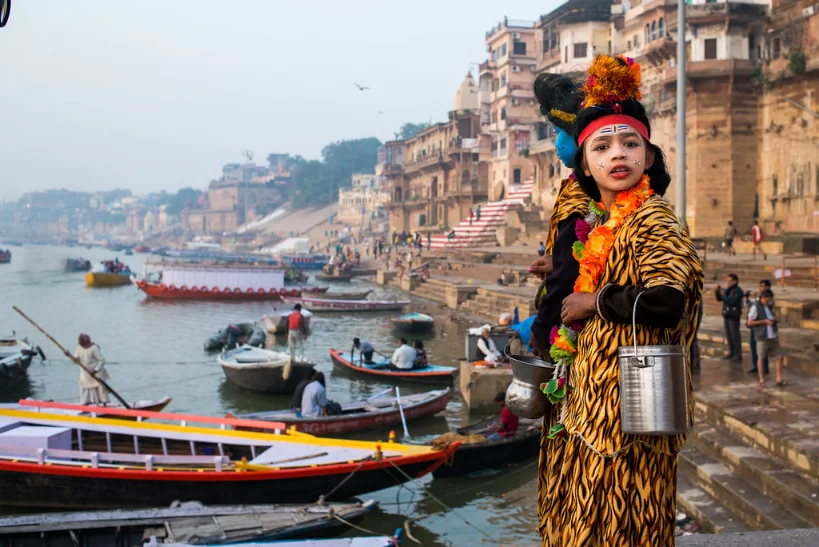
Varanasi Ghats, with their rich tapestry of history, culture, and spirituality, offer a unique experience for every traveller. As you embark on this journey of exploration, it’s essential to tread with respect and awareness. While Varanasi ghats are a treasure trove of stories and rituals, there are certain etiquettes and considerations to keep in mind.
- Respect Religious Ceremonies: Varanasi is a hub of spiritual activities that occur throughout the day. While it’s tempting to get close, it’s best to observe from a distance and avoid causing any disturbances. Always seek permission before capturing these moments on camera.
- Cremation Ceremonies: These rites, though conducted in public, are deeply personal. Refrain from photographing or recording these ceremonies.
- Interacting with Sadhus: The ghats are home to many ascetics. While some may decline to be photographed, others might oblige in exchange for a fee. Always approach with respect and be prepared for varied reactions. If a sadhu declines, respect their wishes.
- Footwear Considerations: If you’re planning to stroll along the ghats, ensure you wear appropriate footwear for comfort and safety.
- Amenities: For convenience, there are restrooms and eateries available along the ghats.
- Beware of Imposters: You might encounter individuals posing as pandits, eager to share tales and then expect compensation. It’s advisable to maintain a distance and, if you’re keen on a guided experience, arrange for one through your accommodation.
- Approach with an Open Mind: Varanasi holds profound religious significance for many. While certain practices might be unfamiliar or even overwhelming, approach them with an open heart and mind. If something isn’t to your liking, it’s best to move away gracefully without causing a scene.
- Keep a Travel Guide Handy: Varanasi offers more than just its iconic ghats. The city brims with diverse experiences, from its ancient temples to delectable street food and beyond. Dive deeper into all that Varanasi has to offer in this comprehensive travel guide.
Why Choose Savaari for Your Varanasi Ghats Exploration?
Navigating the intricate lanes leading to the ghats of Varanasi can be both overwhelming and exhausting, especially if you’re keen on immersing yourself in the essence of more than one ghat. The myriad of transport options available might seem confusing, with many charging exorbitant rates without guaranteeing a satisfactory experience. This is where Savaari steps in as your trusted travel companion.
Whether you’re a solo traveller or journeying with family, the importance of dependable transportation cannot be overstated. Savaari not only ensures transparent pricing but also promises a journey in a comfortable cab tailored to your preference. But the Savaari experience doesn’t end with just a ride. Our seasoned drivers, with their rich local knowledge, double up as your informal guides. They can introduce you to hidden gems, suggest the most authentic street food, or even recommend lesser-known activities that capture the spirit of Varanasi.
To embark on this unparalleled journey, simply download the Savaari app. As you traverse the spiritual heart of India, let Savaari be the chariot that carries you through, ensuring a seamless, memorable, and authentic Varanasi experience. After all, travel is as much about the journey as it is about the destination.
Last Updated on September 6, 2023 by Shabari Shankar




